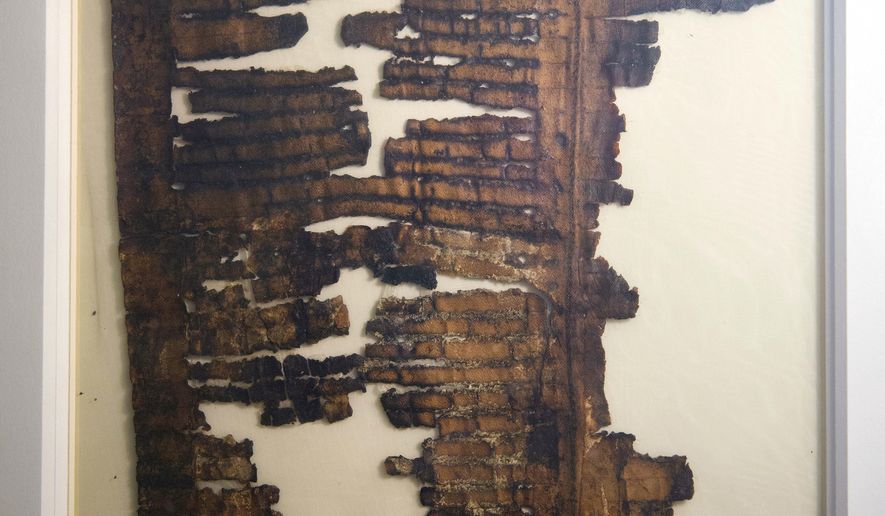Translation predates oldest extant Greek manuscripts by at least a century, adds important detail, scholars say

A fragile fragment of an enigmatic Dead Sea Scroll is on public display at the Israel Museum for the first time since its discovery 70 years ago, in Jerusalem, Tuesday, March. 20, 2018. The Genesis Apocryphon, the sole copy of … more >
By Mark A. Kellner - The Washington Times - Thursday, April 13, 2023
Scholars have discovered a 1,750-year-old portion of the Gospel of Matthew in a “layered” manuscript where the original Old Syriac-language writing had been erased and written over, something also known as a “palimpsest,” the Austrian Academy of Sciences announced.
The portion includes an ancient version of Matthew 12:1 that augments the earliest known Greek manuscripts, which the Old Syriac predates by at least a century.
The New King James Version, based on those Greek manuscripts, reads “at that time Jesus went through the grainfields on the Sabbath; and his disciples became hungry and began to pick the heads of grain and eat.”
The Old Syriac adds an additional description to the last clause, saying the disciples “began to pick the heads of grain, rub them in their hands, and eat them.”
Picking the grain heads and rubbing them was considered “work” by the Jewish leaders of the period and therefore not done on the day of rest. The rebuke by the Pharisees who saw this elicited Jesus’ rebuttal that he was “Lord even of the Sabbath” in Matthew 12:8.
By Mark A. Kellner - The Washington Times - Thursday, April 13, 2023
Scholars have discovered a 1,750-year-old portion of the Gospel of Matthew in a “layered” manuscript where the original Old Syriac-language writing had been erased and written over, something also known as a “palimpsest,” the Austrian Academy of Sciences announced.
The portion includes an ancient version of Matthew 12:1 that augments the earliest known Greek manuscripts, which the Old Syriac predates by at least a century.
The New King James Version, based on those Greek manuscripts, reads “at that time Jesus went through the grainfields on the Sabbath; and his disciples became hungry and began to pick the heads of grain and eat.”
The Old Syriac adds an additional description to the last clause, saying the disciples “began to pick the heads of grain, rub them in their hands, and eat them.”
Picking the grain heads and rubbing them was considered “work” by the Jewish leaders of the period and therefore not done on the day of rest. The rebuke by the Pharisees who saw this elicited Jesus’ rebuttal that he was “Lord even of the Sabbath” in Matthew 12:8.
The text fragment was identified by medievalist Grigory Kessel, who used ultraviolet photography to study the document found in the Vatican Library. The Austrian academy said in a news release the discovery confirms the veracity of the Old Syriac translations of the initial New Testament books.
“The tradition of Syriac Christianity knows several translations of the Old and New Testaments,” Mr. Kessel said in the release. “Until recently, only two manuscripts were known to contain the Old Syriac translation of the gospels.”
Those two are housed at the British Library in London and St. Catherine’s Monastery at Mount Sinai.
These fragments from the third manuscript came to light during the academy’s “Sinai Palimpsests Project.”
Claudia Rapp, director of the Institute for Medieval Research at the Austrian academy, called Mr. Kessel’s find “a great discovery” which “proves how productive and important the interplay between modern digital technologies and basic research can be when dealing with medieval manuscripts.”
Detailed results of the Kessel project are published in the latest issue of the academic journal New Testament Studies.
• Mark A. Kellner can be reached at mkellner@washingtontimes.com.
Copyright © 2023 The Washington Times, LLC.
No comments:
Post a Comment